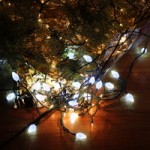It’s been a week since we put up the Christmas tree we cut down at Ticonderoga Farms. It was the first time we’d bought a tree as a married couple (I think) and for sure the first time as parents. But it was something I did yearly as a kid, and I always enjoyed it.
It’s been such a delight to have the gently decorated tree in the house. I’m surprised how happy it makes me. One un-green compromise, though: I couldn’t stand the techno look of the LED lights my husband got, so we are still using the little twinkle ones, about which I haven’t done much research.
More on the joy part of this on Tuesday, but here’s part of a piece I wrote last week on my column at The Washington Times Communities Family Today that discusses the choice whether or not to go with a real tree.
Eco-minded families face a quandary when Christmas season approaches: To tree or not to tree? While a real tree in one’s home might seem like you’re exalting nature’s beauty, it’s not that simple.
For families that celebrate Christmas and try to do so in a “green” way, there are a number of considerations for decorations.
A live tree has taken years to grow and will then only have a short life in the home if cut. Pretty wasteful! Be sure to find a tree recyling program so that your tree gets turned into mulch or at least doesn’t get tossed in a landfill.
Another worry is pesticides: that tree might be filled with them, just like conventional, non-organic flowers are. It’s not good for anyone to bring toxins into their home, but especially not for families with children or for women dealing with fertility issues.
For folks who have their heart set on cutting down a tree of their own, the best option is to talk with the farm about their spraying practices. Although it’s not listed on Green Promise’s guide to”Organic Christmas Tree Farms,” or on Beyond Pesticide’s lists of resources on organic trees and wreaths, Chantilly, Virginia’s Ticonderoga Farms reported that it does not spray its trees (or its pumpkins at Halloween time).
Going out to Ticonderoga’s holiday festival can be a whole day of fun for kids, with slides and all sorts of little houses to climb around on. But if Junior tires out and you decide instead to go with a pre-cut tree, do note that Fraser Firs don’t grow in Virginia and have been brought in from another farm. Your carbon footprint — after driving all the way to Chantilly in the first place — just got bigger.
If you’re handy in the garden and the ground is not too hard in December, consider buying a living Christmas tree to plant after the holiday. Ticonderoga sells these balled beauties, too. The farm recommends not keeping balled trees in the house for more than 12 days, so buy late.
Artificial trees obviously get more use than a one-time cut tree, but plastic doesn’t grow on trees: it has to be manufactured. That’s often in China, with a lot of toxins and not a lot of fair labor practices. The Daily Green describes what to look for in an artificial tree, including an American-made tree.

[…] D.C. Metro « Like this: Christmas tree in the house! […]